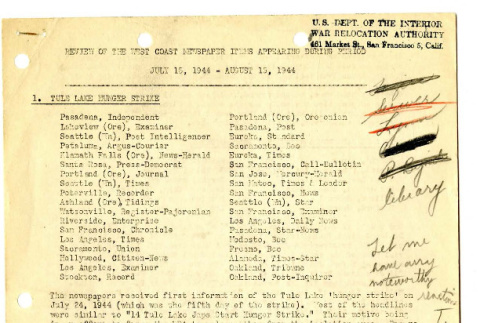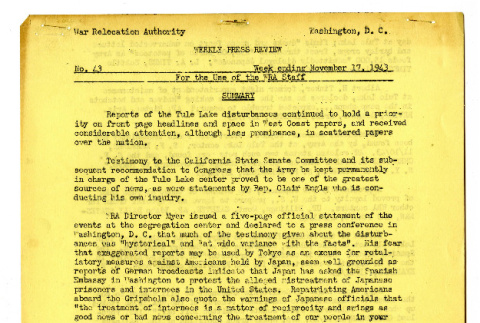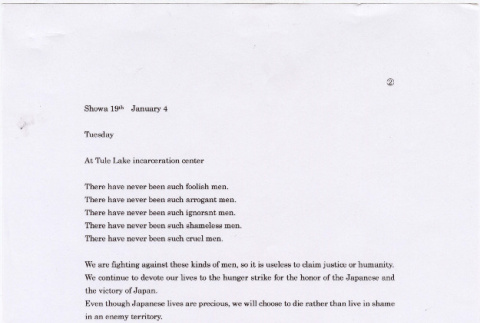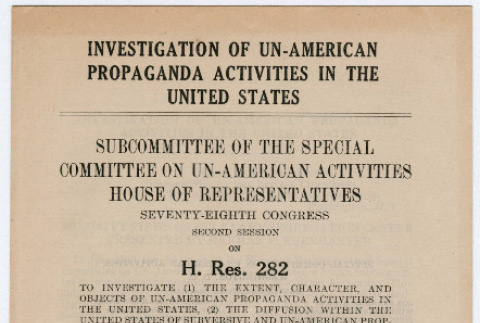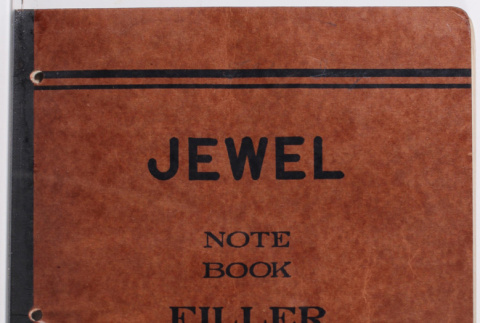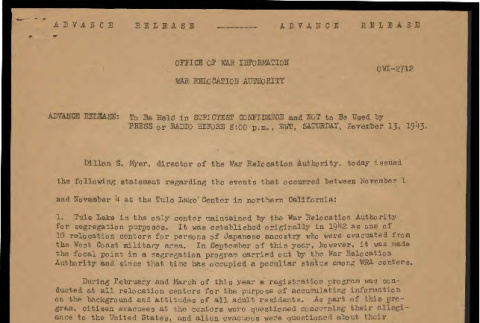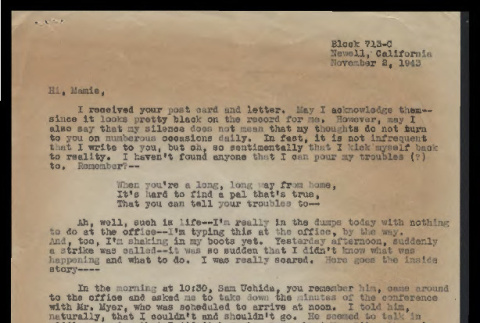Tule Lake strike
World War II
(231)
Concentration camps
(1434)
Conflicts, intimidation, and violence
(260)
Tule Lake strike
(23)
23 items
23 items
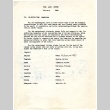
doc
Memo from multiple incarcerees to the Co-ordinating Committee, February 1944 (ddr-csujad-2-89)
States that the incarcerees wish to see "normalcy re-established" and peace and cooperation preserved between the Administration and the "Colony" in the Tule Lake incarceration camp, pledging support for the Co-ordinating Committee's efforts to attain peace at the camp. A handwritten annotation next to one of the people's names provides his or her release date. Names …
![Letter from [William] J. Fujimoto, from the stockade, to Mr. [Raymond R.] Best, Project Director, February 23, 1944 (ddr-csujad-2-92)](https://ddr.densho.org/media/cache/71/2c/712c54aa85d9714797ed9b95e51a8a95.jpg)
doc
Letter from [William] J. Fujimoto, from the stockade, to Mr. [Raymond R.] Best, Project Director, February 23, 1944 (ddr-csujad-2-92)
Describes Fujimoto's imprisonment, for 34 days at the time of writing; Fujimoto states that the cause for his arrest has never been made clear, especially given that he has "never entertained radical ideas" and has been cooperative with authorities, and requests a meeting with Best to review his case. See this object in the California State …
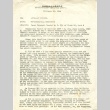
doc
Memo from Co-ordinating Committee to the Advisory Council, February 18, 1944 (ddr-csujad-2-93)
Memo regarding peace movement headed by I. Uji of Block 53, Ward 6. Text provides Uji's full name (Iwao Uji) and also mentions June Sasaki and "Mrs. Matsuda" as other leaders of the peace movement; discusses their request for direct consultation with the Advisory Council. See this object in the California State Universities Japanese American Digitization …
![[Call troops in new outbreak], newspaper article on Tule Lake protests, November 5, 1943 (ddr-csujad-2-37)](https://ddr.densho.org/media/cache/56/ac/56ac536e0ce0a757cb7507684b849494.jpg)
doc
[Call troops in new outbreak], newspaper article on Tule Lake protests, November 5, 1943 (ddr-csujad-2-37)
Newspaper article about protests at Tule Lake Camp in November, 1943 which led to martial law being in place for three months. Describes thousands of incarcerees protesting and the US army sent in for assistance. See this object in the California State Universities Japanese American Digitization project site: sjs_sch_0037
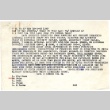
doc
Correspondence regarding need for Internal Security staff, December 1943 (ddr-csujad-2-85)
Teletype from John H. Provinse to Dillon S. Myer requesting additional staff for the police department in very of the "general upset conditions now existing here" (December 3, 1943); teletype from Earl D. Brooks of the WRA Personnel Division approving some positions and requesting additional information for others (December 6, 1943); and letter from Willard E. …

doc
Letter from Ernest M. Kozuma to Ramond Best, Director of Tule Lake Camp, February 21, 1944 (ddr-csujad-2-9)
Detailed letter from Ernest Kozuma to Raymond Best, Director of Tule Lake Camp, explaining his character and request for his release from the army stockades at Tule Lake Camp. Includes descriptions of his activities in the incarceree-led government at Tule Lake, and mention of the Tule Lake Farm Strike. See this object in the California State …

doc
Manzanar diary (ddr-csujad-34-1)
One diary written by Hiroshi Fukuwa, a Kibei Nisei of Los Angeles, California. His diary starts from his departing day from Los Angeles to move into the Manzanar incarceration camp as one of the first group of volunteer incacerees. He was transferred to the Gila River camp, Arizona, to join his brother's family, and segregated into …
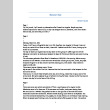
doc
Manzanar diary (ddr-csujad-34-2)
English translation of a diary written by Hiroshi Fukuwa, a Kibei Nisei of Los Angeles, California. His diary starts from his departing day from Los Angeles to move into the Manzanar incarceration camp as one of the first group of volunteer incacerees. He was transferred to the Gila River camp in Arizona, to join his brother's …
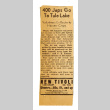
doc
400 Japs go to Tule Lake: volunteers en route to harvest crops (ddr-csujad-34-8)
A newspaper clipping. It reports that 400 Japanese American incarcerees were hired from other camps to harvest crops in the Tule Lake camp while the incarcerees in the Tule Lake went on strike. It portraits the Tule Lake incarcerees as "disloyal Japs." See this object in the California State Universities Japanese American Digitization project site: hrs_06_001
![[Ray R. Best had close call with detention camp mob], biographical news article on Tule Lake Camp Director Raymond Best (ddr-csujad-2-39)](https://ddr.densho.org/media/cache/2a/f2/2af201818f89feb858057c14874aa4ee.jpg)
doc
[Ray R. Best had close call with detention camp mob], biographical news article on Tule Lake Camp Director Raymond Best (ddr-csujad-2-39)
Biographical newspaper article about Tule Lake Camp Director Raymond R. Best and his role during the November 1943 protests at the camp, lead to martial law. Describes how his life was in danger during the protests and his diplomatic work after the camp closed. See this object in the California State Universities Japanese American Digitization project …
![Memo from Harry L. Black, Advisory Committee, to Mr. [Raymond R.] Best, February 8, 1944 (ddr-csujad-2-91)](https://ddr.densho.org/media/cache/99/94/999459383d93bcf40af45ee69118aea9.jpg)
doc
Memo from Harry L. Black, Advisory Committee, to Mr. [Raymond R.] Best, February 8, 1944 (ddr-csujad-2-91)
Memorandum regarding meeting with Co-ordinating Committee. Concerns meeting to discuss Committee's recommendation to release "18 additional detainees from the stockade." The memo on "Executive Office of the President, Office for Emergency Management" letterhead, also discusses employment of incarcerees from Manzanar and Tule Lake and moving incarcerees out of and into various housing blocks. See this object …

doc
Two newspaper articles on Tule Lake Camp protests (ddr-csujad-2-42)
Two newspaper articles on protests and riots at Tule Lake camp November, 1943 which led to martial law being in place for three months. See this object in the California State Universities Japanese American Digitization project site: sjs_sch_0042
![[WRA deny Japanese in riot], newspaper article on Tule Lake protests, November 3, 1943 (ddr-csujad-2-38)](https://ddr.densho.org/media/cache/c1/03/c10309a451eb19d388775d5401d6e911.jpg)
doc
[WRA deny Japanese in riot], newspaper article on Tule Lake protests, November 3, 1943 (ddr-csujad-2-38)
Newspaper article about protests at Tule Lake Camp in November, 1943 which led to martial law being in place for three months. Describes violence among incarcerees. See this object in the California State Universities Japanese American Digitization project site: sjs_sch_0038
![[Troops alert as Tule Japs defy Colonel], newspaper article on Tule Lake protests, November 13, 1943 (ddr-csujad-2-40)](https://ddr.densho.org/media/cache/8c/c4/8cc40b97bd7e9f65dc0e0d61821bae0a.jpg)
doc
[Troops alert as Tule Japs defy Colonel], newspaper article on Tule Lake protests, November 13, 1943 (ddr-csujad-2-40)
Newspaper article about protests at Tule Lake Camp in November, 1943 which led to martial law being in place for three months. Article describes Colonel Verne Austin, Commander of Military Police, trying to regain control after the protests. He is quoted as saying "Henceforth the Army, and not trouble making Jap 'committees' will dictate camp life." …
![[Revolt at Tule Lake: Crop workers blamed for riots; Honolulu Japanese led the mob, 1943-11-04] (ddr-csujad-2-41)](https://ddr.densho.org/media/cache/d9/7d/d97d3956265db91016e7c258bd404102.jpg)
doc
[Revolt at Tule Lake: Crop workers blamed for riots; Honolulu Japanese led the mob, 1943-11-04] (ddr-csujad-2-41)
Newspaper article about protests at Tule Lake Camp in November, 1943 which led to martial law being in place for three months. Article describes camp administration refusing to listen to incarceree demands and violence against staff. See this object in the California State Universities Japanese American Digitization project site: sjs_sch_0041

doc
Review of the West Coast newspaper items appearing during period July 15, 1944-August 15, 1944 (ddr-csujad-19-22)
This document talks about the significant events occurred in the Tule Lake incarceration camp like the hunger strike and arrests made for draft dodging during the period from July 15 to August 15, 1944. See this object in the California State Universities Japanese American Digitization project site: WRA_01-13_01
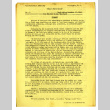
doc
Weekly Press Review, no. 43, November 17, 1943 (ddr-csujad-19-59)
This is the weekly press review which talks about the disturbances and significant incidents in the Tule Lake segregation center. See this object in the California State Universities Japanese American Digitization project site: WRA_02-13_02

doc
Hunger strike at Tule Lake (ddr-densho-394-2)
Journal entries describing a hunger strike at Tule Lake during January 1944.
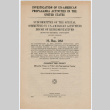
doc
Committee Print of Minority Views on Tule Lake Segregation Center (ddr-densho-356-1039)
Investigation of Un-American Propaganda activities in the United States: Subcommittee of the Special Committee on Un-American Activities House of Representatives, House Resolution 282, Minority Views on Tule Lake Segregation Center. Minority report by Repressive Herman P. Eberharter of Pennsylvania regarding the Tule Lake Strike and recommendations for WRA leadership regarding their actions during the strike.
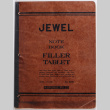
doc
Takeharu Inouye Diary (ddr-densho-365-1)
Takeharu Inouye's first diary documents his family's forced move to the Sacramento Assembly Center, followed by their move to the Tule Lake concentration camp. Since his mother, Miyoe Inouye, was a teacher, thirteen-year-old Takeharu's diary focuses on his classes in the Japanese and American schools at Tule Lake. His struggles with his schoolwork, as well as …
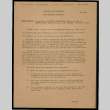
doc
Advance release (Office of War Information), OWI-2712 (November 1, 1943) (ddr-csujad-55-1908)
Press release regarding the purpose and process of segregation at Tule Lake, movement of segregants between WRA Centers, security at Tule Lake, unrest among incarcerees, strike and violence, interventions by the administration, and international press. See this object in the California State Universities Japanese American Digitization project site: sac_jaac_1911
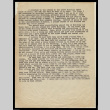
doc
Letter regarding strike Tule Lake in November 1943 (ddr-csujad-55-131)
Statement describing the strike and events that occurred at the Tule Lake incarceration camp on November 4, 1943. See this object in the California State Universities Japanese American Digitization project site: sac_jaac_0133

doc
Letter to Mamie, November 2, 1943 (ddr-csujad-55-130)
Correspondence to Mamie describing events that occurred at Tule Lake incarceration camp on November 1, 1943. Correspondent describes the labor strike, a visit from Dillon S. Myer, director of the War Relocation Authority, a crowd of Japanese gathering at the camp administration building, the army's response, and the beating of Dr. Pedicord. See this object in …
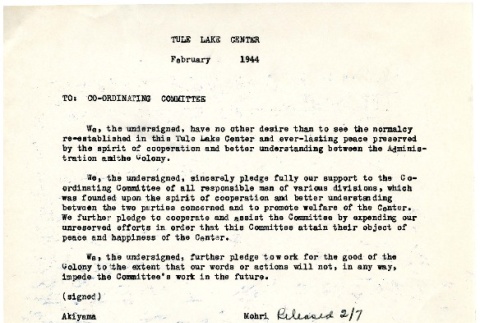
![Letter from [William] J. Fujimoto, from the stockade, to Mr. [Raymond R.] Best, Project Director, February 23, 1944 (ddr-csujad-2-92)](https://ddr.densho.org/media/cache/a5/f6/a5f601c235c1a343829fb57e90b4cda1.jpg)

![[Call troops in new outbreak], newspaper article on Tule Lake protests, November 5, 1943 (ddr-csujad-2-37)](https://ddr.densho.org/media/cache/ea/29/ea295ed7535bc9180d02b08e4bcd390d.jpg)
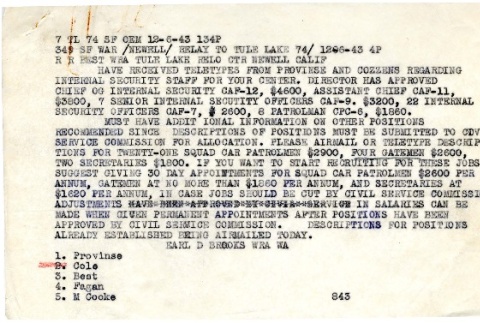
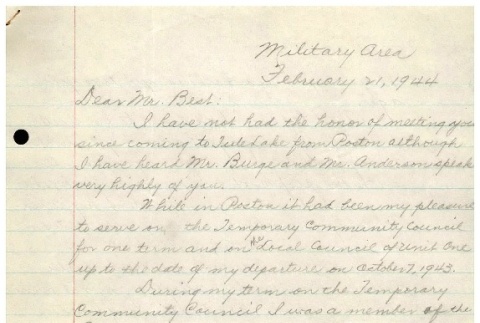


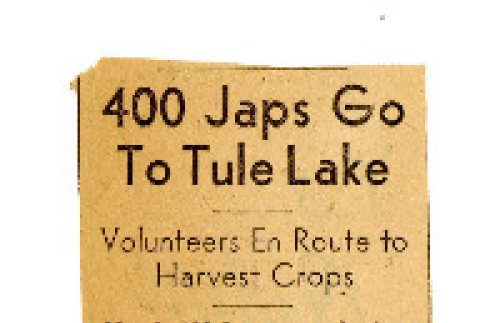
![[Ray R. Best had close call with detention camp mob], biographical news article on Tule Lake Camp Director Raymond Best (ddr-csujad-2-39)](https://ddr.densho.org/media/cache/d3/7b/d37bf03e591c4a69d0e2e1e57a6e8e67.jpg)
![Memo from Harry L. Black, Advisory Committee, to Mr. [Raymond R.] Best, February 8, 1944 (ddr-csujad-2-91)](https://ddr.densho.org/media/cache/97/9f/979fe83faee38355fb14a9b76d0e063b.jpg)
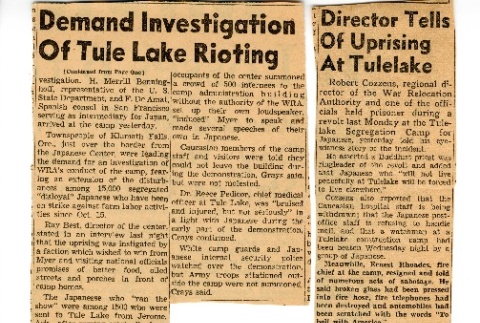
![[WRA deny Japanese in riot], newspaper article on Tule Lake protests, November 3, 1943 (ddr-csujad-2-38)](https://ddr.densho.org/media/cache/42/6f/426f079133d2244d6ceea7ac982a70de.jpg)
![[Troops alert as Tule Japs defy Colonel], newspaper article on Tule Lake protests, November 13, 1943 (ddr-csujad-2-40)](https://ddr.densho.org/media/cache/33/f8/33f88bfedf28143ae307c02d59a808ed.jpg)
![[Revolt at Tule Lake: Crop workers blamed for riots; Honolulu Japanese led the mob, 1943-11-04] (ddr-csujad-2-41)](https://ddr.densho.org/media/cache/48/c2/48c29669604489ee581e8bf57e48d667.jpg)
